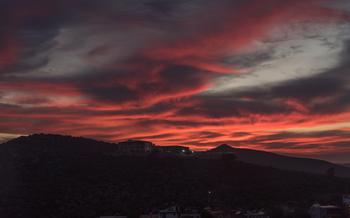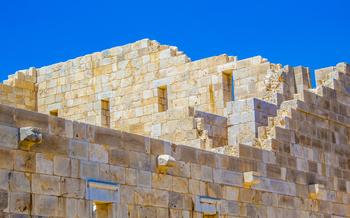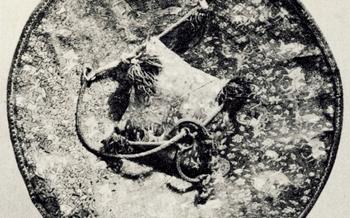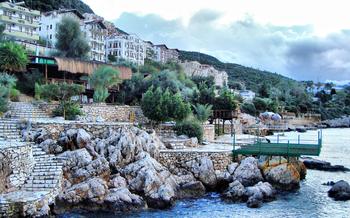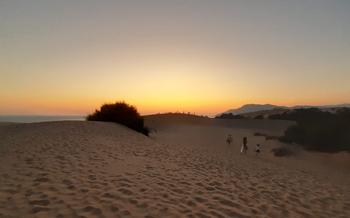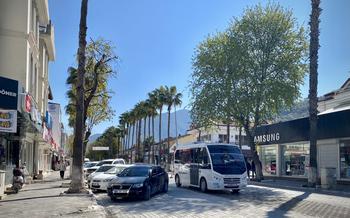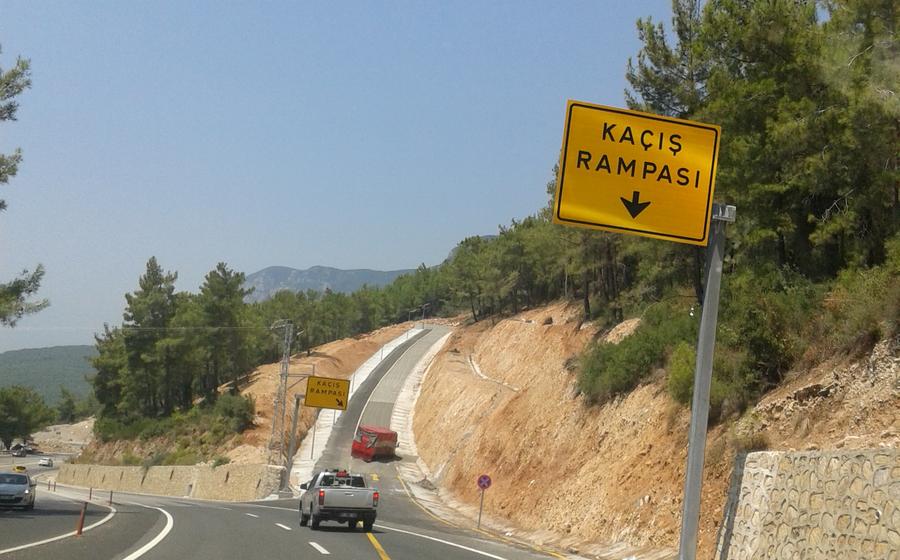
Patara Ancient City and Beach
- Patara: An Ancient Lycian City
- Patara's Sandy Beaches
- Patara Amphitheater: A Timeless Stage Overlooking the Turquoise Coast
- Patara Lighthouse
- Patara's Unique Flora and Fauna
- Diverse Flora
- Rich Fauna
- Conservation Efforts
- Personal Anecdote
- Visiting Patara from Nearby Towns
- Local Cuisine and Restaurants in Patara
- Insider Tip:
- Accommodation Options in Patara
- Patara in Ancient Lycia
- Patara's Role in the Roman Empire
- Patara in Byzantine and Ottoman Times
- Changing Urban Landscape and Cultural Influences
- Patara in Modern Times
- Insider Tip
Patara: An Ancient Lycian City
Patara, a city with a rich history, was once a major port and religious center of ancient Lycia, renowned for its prominent role in trade and the worship of Apollo. Situated along the Turquoise Coast and in close proximity to the Xanthos Valley, Patara's strategic location contributed to its significance as a maritime hub and a gateway to the region's interior. Archaeological excavations have brought to light remarkable ruins, including city walls, gates, an agora, a theater, and temples, providing glimpses into the city's glorious past. Patara's well-preserved remains captivate ancient history enthusiasts, archaeology buffs, and travelers seeking immersive cultural experiences, inviting them to step back in time and explore the grandeur of this ancient Lycian city.
Patara's Sandy Beaches
Patara Beach, stretching along 18 kilometers of pristine coastline, is one of Turkey's most breathtaking natural wonders. Its golden sands, crystal-clear waters, and idyllic setting make it a paradise for sunseekers, swimmers, and nature enthusiasts alike.
As a protected area, Patara Beach serves as a nesting site for the endangered Caretta-Caretta sea turtles, adding to its ecological significance. Visitors can witness these majestic creatures up close during guided turtle-watching tours, contributing to conservation efforts while creating unforgettable memories.
Whether you prefer basking in the sun, taking a refreshing dip in the sea, or simply strolling along the shore, Patara Beach offers an array of experiences. Sun loungers and umbrellas are available for rent, allowing you to relax and soak up the Mediterranean sun. Water sports enthusiasts can indulge in activities like windsurfing, kitesurfing, and stand-up paddleboarding.
To make the most of your beach day, plan your visit during the shoulder seasons (May-June and September-October) when the weather is pleasant, and the crowds are smaller. Remember to pack essentials like sunscreen, sunglasses, a hat, and plenty of water to stay hydrated. For a delightful culinary experience, savor fresh seafood and traditional Turkish dishes at the beachside restaurants, offering panoramic views of the stunning coastline.
Patara Amphitheater: A Timeless Stage Overlooking the Turquoise Coast
In the heart of the ancient city of Patara, nestled amidst the ruins, lies a majestic amphitheater that has stood the test of time. With a seating capacity of approximately 5,000 spectators, this architectural marvel once reverberated with the sounds of theatrical performances, gladiatorial contests, and public gatherings.
The Patara Amphitheater is a testament to the grandeur and sophistication of the ancient Lycian civilization. Constructed in the 2nd century AD, it boasts remarkably well-preserved tiers of seating, a spacious orchestra, and an impressive stage building. The intricate carvings and architectural details that adorn its façade hint at the artistry and craftsmanship that went into its construction.
Throughout history, the amphitheater has served as a stage for a variety of events. In ancient times, it hosted theatrical performances, ranging from comedies to tragedies, that drew audiences from across the region. Gladiatorial contests, a brutal form of entertainment popular in the Roman Empire, were also held within its walls. These events showcased the prowess of skilled fighters and often resulted in bloody spectacles.
In addition to entertainment, the amphitheater served as a venue for public gatherings and civic events. Important announcements, political speeches, and religious ceremonies took place within its confines. The acoustics of the amphitheater ensured that even those seated in the furthest rows could hear the proceedings clearly.
Today, the Patara Amphitheater stands as a silent witness to the vibrant past of this ancient city. Visitors can wander through its tiers, imagining the roar of the crowd as they watch the ruins come alive with history. The amphitheater is a reminder of the enduring legacy of Patara and its significant role in the cultural and social life of the ancient world.
Patara Lighthouse
The ancient lighthouse of Patara stands as a testament to the ingenuity and maritime prowess of the ancient world. Believed to be one of the tallest and most significant lighthouses of its time, it served as a beacon of hope for seafaring vessels navigating the treacherous waters of the Mediterranean Sea.
The lighthouse's construction, estimated to date back to the 2nd century AD, was a remarkable feat of engineering. Its towering structure, reaching an estimated height of over 30 meters, was built using massive stone blocks and intricate architectural techniques.
While the lighthouse has undergone significant wear and tear over the centuries, its grandeur remains evident. The ruins of its base, along with scattered fragments and inscriptions, provide valuable insights into its design and construction. Ongoing archaeological research continues to shed light on the lighthouse's history and its role in ancient maritime trade and navigation.
Although the lighthouse is no longer operational, its legacy lives on as a symbol of Patara's maritime heritage. Visitors can explore the site and marvel at the ingenuity of ancient engineers who constructed this beacon of light, guiding countless ships to safety through the dark and stormy seas.
Patara's Unique Flora and Fauna
Patara is not just a historical and cultural treasure but also a haven for nature enthusiasts. The region boasts a diverse array of flora and fauna, including rare and endangered species. The Patara Special Environmental Protection Area, established in 1988, aims to preserve the unique natural ecosystems of the region.
Diverse Flora
The Patara region is home to a wide variety of plant species, including endemic and rare ones. The coastal dunes are characterized by sea daffodils, sea lilies, and the endangered Patara spurge. The scrublands and forests contain Aleppo pines, Phoenician junipers, mastic trees, and various aromatic herbs. Visitors can enjoy guided nature walks or birdwatching tours to discover the rich botanical diversity of the area.
Rich Fauna
Patara's diverse habitats support a variety of animal species, including reptiles, amphibians, birds, and mammals. The loggerhead sea turtles (Caretta caretta) are the most famous residents of Patara, nesting on its sandy beaches. Other reptiles include green turtles, spur-thighed tortoises, and various lizard and snake species. The area is also home to a variety of bird species, including migratory birds such as flamingos, herons, and egrets.
Conservation Efforts
Conservation efforts are crucial to preserving Patara's unique flora and fauna. The Patara Special Environmental Protection Area regulations aim to minimize human impact on the ecosystem. Visitors are encouraged to follow responsible tourism practices, such as staying on designated trails, avoiding disturbing wildlife, and properly disposing of waste.
Personal Anecdote
During my visit to Patara, I had the privilege of participating in a guided nature walk. Our knowledgeable guide pointed out various plant and animal species, including the endangered Patara spurge and a rare chameleon. It was a fascinating experience to learn about the unique biodiversity of this region and the importance of conservation efforts to protect it.
Visiting Patara from Nearby Towns
Patara's allure extends beyond its own borders, beckoning travelers from neighboring towns to embark on a journey through history and natural beauty. From the vibrant streets of Fethiye, a scenic 45-minute drive along the Turquoise Coast leads to Patara. Ölüdeniz, renowned for its breathtaking Blue Lagoon, is a mere 30-minute drive away, offering a convenient escape to ancient wonders. Kalkan, a charming town nestled amidst picturesque bays, is a 1-hour drive from Patara, providing a tranquil base for exploring the region's treasures.
Public buses offer a budget-friendly option for travelers, connecting Patara with these nearby towns. Rental cars provide the freedom to explore the region at your own pace, allowing for spontaneous detours and stops at hidden gems along the way. Organized tours are available for those seeking a hassle-free experience, with knowledgeable guides providing insights into the history and significance of Patara.
Whether embarking on a day trip or a multi-day excursion, Patara awaits with open arms, ready to unveil its timeless charm and transport visitors to a world where history, nature, and culture intertwine.
Local Cuisine and Restaurants in Patara
The Muğla region is renowned for its delectable cuisine, and Patara offers a tantalizing array of culinary delights. Fresh seafood takes center stage, with succulent grilled fish, fragrant shrimp dishes, and mouthwatering octopus stews being must-try delicacies. Olive oil, a staple of Turkish cuisine, features prominently in many local dishes, imparting a rich and savory flavor. Traditional Turkish fare is also well-represented, with yaprak sarması (stuffed vine leaves), güveç (clay-pot casseroles), and keşkek (a hearty dish made from bulgur and meat) being popular choices.
For a memorable dining experience, head to one of the charming restaurants in Patara, many of which offer panoramic views of the stunning beach. Savor the flavors of the region while enjoying the breathtaking scenery. Whether you prefer a casual lunch spot or an upscale dinner venue, Patara has something to offer every palate.
Insider Tip:
- For an authentic taste of Turkish cuisine, try the freshly caught fish grilled to perfection and served with a squeeze of lemon and a drizzle of olive oil. It's a simple yet delicious dish that showcases the region's culinary prowess.
Accommodation Options in Patara
Patara offers a range of accommodation options to suit different budgets and preferences. For budget-conscious travelers, guesthouses and campsites provide affordable options with basic amenities. Mid-range hotels offer modern comforts and convenient locations, often with stunning views of the beach or the ruins. For a luxurious experience, resorts with private beach access and upscale amenities cater to those seeking indulgence and relaxation.
When choosing your accommodation, consider the time of year you are visiting. During peak season (June to September), it is advisable to book in advance to secure your preferred option. Online booking platforms and local travel agencies can assist you in finding the best deals and availability.
Once in Patara, you will find that the charm of the town extends to its accommodations. Many guesthouses and small hotels are family-run, offering warm hospitality and a glimpse into the local way of life. Whether you choose a simple room with a view of the ruins or a luxurious suite by the beach, your stay in Patara promises to be a memorable one.
Patara in Ancient Lycia
Patara's history is deeply intertwined with the ancient Lycian civilization, a group of indigenous people who inhabited the region of Lycia in southwestern Anatolia from the 5th century BC to the 2nd century AD. Patara was one of the most prominent city-states within the Lycian League, a confederation of cities that united for mutual defense and cooperation. The Lycians were renowned for their seafaring skills, their unique culture, and their resistance to foreign invaders. Their legacy can still be seen in the impressive ruins of Patara and other Lycian cities, such as Xanthos, Letoon, and Myra. Exploring these sites offers a glimpse into the rich history and vibrant culture of the ancient Lycians.
Patara's Role in the Roman Empire
During the Roman period, Patara emerged as a prominent port city and trading hub, playing a crucial role in the administration, taxation, and military campaigns of the vast Roman Empire. The city's strategic location along the Turquoise Coast and the fertile Xanthos Valley contributed to its importance as a center of commerce and trade. Archaeological excavations have revealed impressive evidence of Roman influence in Patara, including the well-preserved Roman baths with intricate mosaics and architectural features. The city's theater, capable of accommodating approximately 5,000 spectators, served as a venue for theatrical performances, gladiatorial contests, and public gatherings. Patara's significance in the Roman Empire is further attested by historical accounts that mention its role in Roman administration, taxation, and military campaigns. Exploring the Roman ruins in Patara offers a glimpse into the city's vibrant past and its contributions to the Roman Empire's power and prosperity.
Patara in Byzantine and Ottoman Times
In the 4th century AD, Patara transitioned into a Byzantine city, becoming a significant religious center and a hub for Christian pilgrims. The city's churches and monasteries flourished, and the remains of several Byzantine structures, including a basilica and a baptistery, can still be seen today.
During the Ottoman period, Patara's importance gradually declined. The city's population dwindled, and the once-bustling port fell into disuse. The ruins of Patara were largely forgotten and remained buried under sand dunes for centuries.
Changing Urban Landscape and Cultural Influences
During the Byzantine and Ottoman periods, Patara's urban layout underwent significant changes. The city expanded beyond its original boundaries, and new neighborhoods were constructed. Byzantine churches and monasteries were built, while Ottoman mosques and madrasahs were erected, reflecting the changing religious and cultural influences.
Over time, Patara's strategic importance diminished, and the city eventually lost its prominence. The once-thriving port was abandoned, and the ruins of Patara were left to the elements. However, in recent decades, archaeological excavations have brought Patara back to light, revealing its rich history and cultural heritage.
Patara in Modern Times
Patara's rediscovery in the 19th century sparked a renewed interest in its rich history and cultural significance. Extensive archaeological excavations commenced, revealing the grandeur of the ancient city's ruins and shedding light on its past. These excavations continue to this day, uncovering new artifacts and providing valuable insights into the lives of the people who once inhabited Patara.
One of the key challenges facing Patara in modern times is the delicate balance between tourism development and the preservation of its natural and cultural heritage. As the site's popularity grows, managing the influx of visitors while protecting the fragile ruins and ecosystem is paramount. Sustainable tourism initiatives have been implemented, such as guided tours that minimize environmental impact and promote responsible behavior among visitors.
Despite the challenges, Patara remains a captivating destination for history buffs, nature enthusiasts, and travelers seeking an authentic glimpse into Turkey's ancient past. Its unique blend of historical ruins, stunning beaches, and diverse flora and fauna make it a must-visit destination for anyone exploring the wonders of the Turquoise Coast.
Insider Tip
For an unforgettable Patara experience, I highly recommend visiting early in the morning or late in the afternoon. The soft golden light during these hours casts a magical glow on the ruins and the beach, creating a serene and almost ethereal atmosphere. Stroll through the ancient city, marveling at the well-preserved structures without the throngs of tourists. Let the gentle sea breeze caress your face as you soak in the tranquility of Patara.
Pack comfortable shoes for exploring the ruins and the beach, as the uneven terrain and soft sand require sturdy footwear. Don't forget your sunscreen, sunglasses, and a hat to protect yourself from the Mediterranean sun. Bring along water and snacks to stay hydrated and energized throughout the day.
Finally, take the time to truly immerse yourself in Patara's history and culture. Read up on the Lycians, the Romans, and the Byzantines who once called this place home. Let your imagination transport you back in time as you wander among the ruins, picturing the bustling streets and vibrant atmosphere of ancient Patara. Trust me, the extra effort will be rewarded with a deeper appreciation and a lasting memory of this extraordinary destination.
